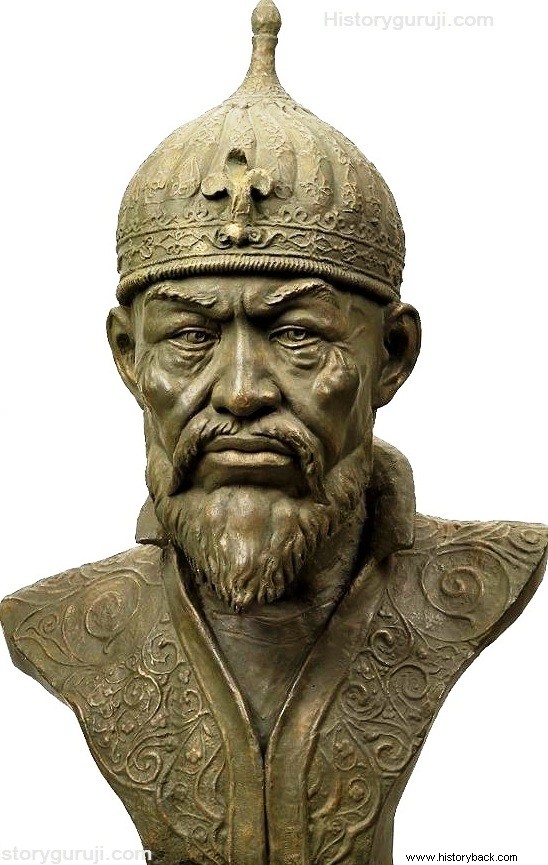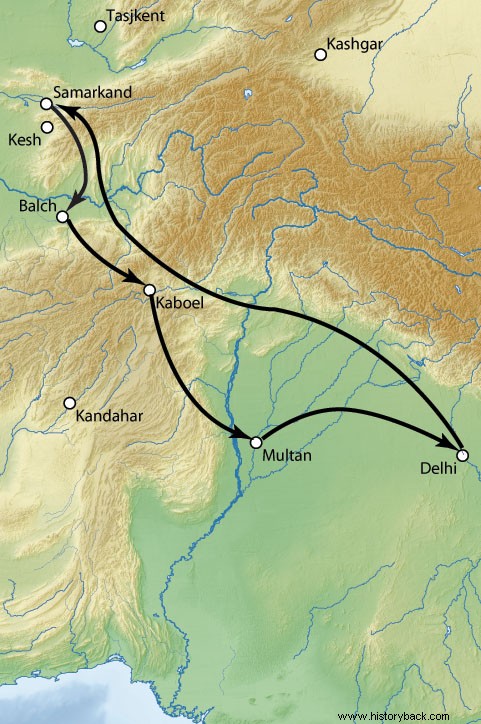Taimurlang, also known as Timur (1336–1405 AD), was a 14th-century military ruler who founded the great Timurid dynasty. The 18th century historian Edward Gibbon has written in relation to Timurlang that 'The countries on which Timur hoisted his conquest, there were also knowingly or unknowingly the birth of Timurlang, his character, personality and even his name Taimurlang. False stories were also circulated about Gibbon further wrote that, 'But in reality he was a warrior, who came from a peasant family and sat on the throne of Asia. Disability did not affect his attitude and spirit. He had conquered even his weaknesses.'
In fact, Taimur's physical disability never came in his way. Even his staunch critics believe that Timurlang was full of strength and courage. He continued to win the battlefield for 35 years. There is no other example in history of becoming a world-conqueror by overcoming his physical infirmities.
Early Life of Taimurlang

Amir Taimur born 8th April, In the year 1336 AD in Trans-Axiana, Mein Cash or 'Shahr-e-Sabj' It happened in a place called He was named Taimur at birth and Taimur means 'iron'. Timur's father Amir Turge Barlas was the head of the Turks of the Gurgan or Chagatai branch of the Turks. In the beginning, Timur was given military education, so he was proficient in warfare. His father Amir Turge had converted to Islam, so Taimur was also a staunch follower of Islam. The founder of the Mughal Empire in India, Zahiruddin Babar, a descendant of this Timur was.
Taimurlang was successful in overcoming the difficulties of life. According to the fifteenth-century Syrian historian Ibn Arabshah, Timur was wounded by a shepherd's arrow while stealing a sheep. According to the Spanish ambassador Clavijo, he suffered a limp for the rest of his life, with his right leg injured while facing Sistan's cavalry, later his right arm was also injured. In fact in 1363 AD When he was working as a hired laborer in the mines falling in Khorasan, at the same time his right side of the body was disabled. His right leg was shorter than the left leg. He had to drag his right leg while walking. This is the reason why people started calling him Taimur-e-Lang (Lame Timur) in Persian. Later this name deteriorated and deteriorated to Taimurlang.
Right to Samarkand
Taimurlang was a very talented and ambitious man. He claimed to be a descendant of Genghis, while he was a Turk. When the Mongol ruler of Samarkand died in 1369 AD, he took over the power of Samarkand. Like Genghis Khan, he wanted to trample the whole world with his power and like Alexander, he wanted world-conquest. He established his military system on the pattern of Genghis Khan and started his journey of conquest and brutality. His kingdom extended from West Asia to Central Asia to India. Between 1380 and 1387 AD, he invaded Khorasan, Sistan, Afghanistan, Persia, Azerbaijan and Kurdistan etc. and subjugated them. In 1393 AD, he established suzerainty over Mesopotamia. Encouraged by these victories, he decided to attack India.
Aim for Taimur's attack
Initially the amirs and chieftains of Timur were not ready to attack a remote country like India, but when he decided to destroy the idolatry practiced in India for the propagation of Islam, it was his holy Declared the goal, then they were ready. His biography 'Tuzuk-e-Taimuri In giving the reason for his attack on India, he writes that 'My aim in attacking Hindustan is to wage a religious war against the infidel Hindus (so that the army of Islam may also get the wealth and valuable things of the Hindus.'
The destruction of idolatry was just an excuse to attack. Timur had heard many stories about India's prosperity and glory, so he planned an attack only to plunder India's wealth. This political weakness of the Delhi Sultanate gave Timurlang an opportunity to attack India.
Status of Delhi Sultanate
The kingdom of Delhi was in disintegration and disrepair at the time of Timur's invasion of India. The condition of the Delhi Sultanate was very deplorable due to the weak successors of Firoz Shah. Three sultans came and went to the throne from 1388 to 1394. , The principle-zero chieftains promoted political anarchy in their selfish pursuits. While living in Firozabad, Nasrat Shah kept making plans to take over Delhi, in Delhi the weak Mahmud Tughlaq had become a puppet in the hands of his chieftains. Almost all the Muslim Subedars and Hindu Nayaks were engaged in establishing their independent authority by disregarding the sovereignty of the Sultan.
Taimur's attack on India
Taimurlang attacked India in early 1398 AD with one of his grandsons Pir Mohammad dispatched to. He crossed the Indus river and captured the region of Uchchha. He laid siege to Multan and conquered it after six months.

After Multan conquest April, 1398 E. In AD Timurlang himself went to attack India with a heavy army from Samarkand and in September he crossed the Indus, Jhelum and Ravi rivers. on October 13 He reached the town of Tulumba, located 70 miles north-east of Multan. He looted this city and committed horrific slaughter and made many slaves. He attacked the fort of Katornami on the border of Kashmir and ordered the construction of a tower of the severed ends of the infidels. After this he reached Bhatner winning Dipalpur.
The Rajputs of Bhatner conceded defeat after a few battles and were granted pardon, but they were attacked by Timur as soon as they were heeded. Timur writes in his biography that 'in a short time all the people of the fort were put to death by the sword. In an hour, 10,000 (ten thousand) people were beheaded. The sword of Islam bathed in the blood of the infidels. My soldiers also plundered their belongings, treasure and grain, which had been gathered in the fort over the years. The houses were set on fire and burnt to ashes. The buildings and fortifications were demolished. The second city was Sarasuti, which was attacked. All the Kafir Hindus were slaughtered. His wife, children and property became ours.'
Proceeding towards Delhi, Taimur entered the territory of the Jats. He ordered his army that 'whoever is found, should be killed.' All the villages or cities that came before the army were ruthlessly looted. Men were slaughtered and some men, women and children were taken captive. There many Hindu temples were destroyed. Thus plundering Sirsa and Kaithal and killing and imprisoning the residents, Timur reached near Delhi at the end of the first week of December.
Invasion of Delhi
On reaching Delhi, Timurlang ordered that all prisoners except the Muslim prisoners be put to death by the sword of Islam. Whoever is negligent in the observance of this order, he should also be killed and his property should be given to the informer. Here about one lakh Hindus were taken captive and killed. December 17, 1398 AD Delhi's weak Tughlaq Sultan Nasiruddin Mahmud was defeated by his Wazir Mallu Iqbal With a huge army of forty thousand foot soldiers, ten thousand cavalry and one hundred and twenty elephants he tried to face Timur near Panipat, but he was badly defeated and frightened and fled towards Gujarat. His Wazir Mallu Iqbal also fled and hid in Baran.
Timur entered Delhi with great fanfare on the second day. He came to know that a large number of Hindus along with their wives and children and valuables had taken refuge in Delhi, fleeing the surrounding countryside. He ordered the soldiers to loot Delhi. 'Zafarnama' The author of Yazdi has written in relation to this attack that 'Here the soldiers of India fought valiantly to protect their lives, but the weak worm could not stand in front of the storm nor the weak deer in front of the fierce lion, so they also ran away. The capital of the Sultans of Delhi fell in misfortune.
Many residents of this fateless city were brutally murdered or taken prisoner. 'Tafarnama' The author writes that 'It was the divine will to destroy the city and punish its inhabitants……the heads of the Hindus were cut into high heaps and their trunks were left for the predatory animals and birds. The residents who somehow survived were taken captive.' India had never suffered so much in a single attack by a conqueror. In this critical situation, nature also showed ruthlessness to the people of Delhi and added to their suffering through bloody wars and destruction. Badayuni writes that 'At this time such an epidemic spread in Delhi that the city was completely destroyed and the residents who survived also died and for two months even a bird did not flap its wings in Delhi.'
Taimur got immense wealth in the loot of Delhi, which included red, diamonds, pearls, gems, asharfis, gold and silver coins, precious utensils, silk and zaridar clothes etc. It was not possible to count the gold and silver ornaments of women. Along with this, he also took many women and craftsmen captive. These craftsmen built many buildings in Samarkand, the most famous of which is the self-planned mosque of Timur. Timur did not intend to stay in India. After staying for fifteen days in Delhi, he home on 1 January, 1399 AD via Firozabad left for.
Loot of Meerut and Haridwar: On his way back from Delhi, Timurlang met meerut on January 9, 1399 AD but marched north and defeated two Hindu armies to the side of Haridwar after plundering and killing the city.
Invasion on Jammu: Taimur rising from the banks of Shivalik hills Kangra on January 16, 1399 reached and took possession of it. After this he marched on Jammu. These places were also looted and innumerable residents were slaughtered. He appointed one of his representatives Khizr Khan as the ruler of Multan, Lahore and Dipalpur. On March 19, 1399, Timur returned to his country Samarkand after crossing the Indus river.
Invasion of Anatolia in 1400 AD from Timur after returning from India and defeated the Ottoman Turks in the Battle of Angora in 1402 AD. in 1405 AD when he was on his way to war against King Ming of China , then he died.
Effect of Timur's Invasion
Taimurlang's invasion completed the disintegration of the Tughlaq Empire. Due to political instability, the provinces of Delhi started becoming independent one by one. Nasrat Shah, who was still hiding in the Doab, tried to capture Delhi in 1399 AD, but he was defeated by Mallu Iqbal and banished from the city. On his return to Delhi in 1401 AD, Mallu Iqbal returned from Dhar on the invitation of Sultan Mahmud. The death of Mallu Iqbal while fighting Khizr Khan on November 12, 1405. happened. The weak Sultan ruled nominally for about twenty years. The end of the Tughlaq dynasty with his death in Kaithal in February, 1413. Done.
